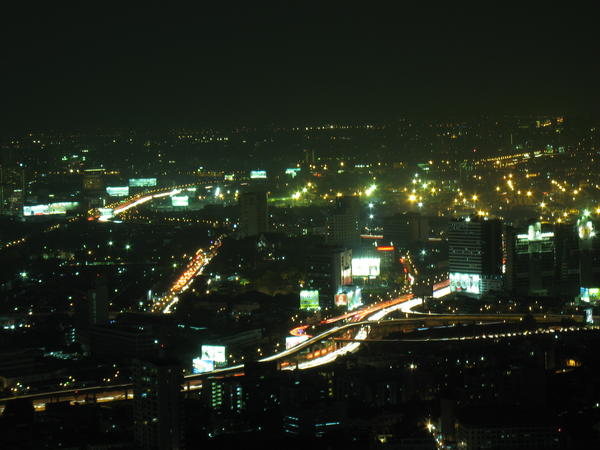Bangkok: Infinite in all directions
Cross-posted at Jon's blog:
Bangkok is truly infinite in all directions.
We had just turned a corner from the nuts-and-bolts district into a more open-air-marketish area. According to our maps, this was indeed the "Thieves Market" - formerly where people would fence stolen goods, now more of a market of randomness in the heart of Bangkok's Chinatown.
We'd wandered through here earlier in the day by accident, and had had our fill of browsing powertools, pirated DVD porn, dollar-store items and kitchenware, so we peeked down a side alleyway that looked likely to go through to the next block over, in our general direction of onward wandering. On a whim, we took it (the joys of careless wandering that a good sense of direction and a local SIM card in a jailbroken iPhone afford you).
THIS was the real thieves market. We had stumbled into an invisible warren of narrow sois and passageways full of everything. From Playstations to cameras to knockoff tablets to boardgames and more, densely packed in a fractaline arrangement - a market in a market in a district full of markets in a city where everything (except a decent martini) seems to be for sale at a price -- the Bangkok Post classifieds, a surprisingly family-friendly section of the paper, still has large paid adverts for liposuction (600USD) and gender reassignment (1600USD). Package deals available.
This is Bangkok, where the downtown mega-mall shopping district got so frustrated with the street-side markets and 6-lane traffic jams slowing down foot-traffic between the office-building sized malls that they built above-ground sidewalks to link them together, as if the city itself were trying to scab over its street vendors and traffic congestion.
It's unmappable. Bangkok has a perfectly understandable system of neighborhoods, main streets and side streets that make navigation - once you grok the system - natural. WikiTravel explains this system the best:
Addresses in Bangkok use the Thai addressing system, which may be a little confusing to the uninitiated. Large roads such as Silom or Sukhumvit are thanon (ถนน), [...] while the side streets branching off from them are called soi (ซอย). Sois are numbered, with even numbers on one side and odd numbers on the other side. Thus, an address like "25 Sukhumvit Soi 3" means house/building number 25 on the 3rd soi of Sukhumvit Road. While the soi numbers on each side will always advance upward, the numbers often do not advance evenly between sides — for example, Soi 55 could be across from Soi 36. Many well-known sois have an additional name, which can be used instead of the number. Sukhumvit Soi 3 is also known as "Soi Nana Nuea", so the address above might thus also be expressed as "25 Soi Nana Nuea". The extension /x is used for new streets created between existing streets, as seen in Sukhumvit's soi pattern 7, 7/1, 7/2, 9, 11. Note that some short alleys are called trok (ตรอก) instead of soi.
To make things a little more complex, some large sois like Soi Ekkamai (Sukhumvit Soi 63) and Soi Ari (Phahonyothin Soi 7) have their own sois. In these cases, an address like "Ari Soi 3" means "the 3rd soi off Soi Ari", and you may even spot addresses like "68/2 Ekkamai Soi 4, Sukhumvit Road", meaning "2nd house beside house 68, in the 4th soi of Ekkamai, which is the 63rd soi of Sukhumvit". In many sois, the house numbers are not simply increasing, but may spread around.
Markets like the thieves market exist in a mix between sois, sub-sois, and a further maze of twisty little passages, all same-same, but different. This system has driven map-makers insane. Guidebooks like the Lonely Planet and Rough Guide have taken to a neighborhood, points-of-interest approach, which is great if you never stray from the path, but confusingly fails to include all the random side-streets, so "the first street on the left" may be very, very misleading. Google seems to be building a more comprehensive map overall, with anything that a two-wheeled vehicle could manage showing up -- but it's not complete, missing some of the better hidden or poorly mapped areas altogether. Open Street Maps is focusing so far on only the larger streets, missing huge swaths of the fractal nature of Bangkok.
The low cost of entry into these markets also mean that there is immense flux - a food stall may only be there a certain chunk of days out of the week, may move, or go out of business. It may have the best fried quail eggs in wanton wrappers in Bangkok, but good luck finding it reviewed at TripAdvisor.
But that misses the point, anyhow. In preparing for the trip, the guidebooks and websites both were failing at restaurant and shopping recommendations. That's because these are not really specific destinations in Thailand, but journeys that every traveler willing to venture out beyond their 5-star hotel or the backpacker ghetto must make on their own. Everyone will choose their own adventure - it will be perfect and unique and unrepeatable. And that, in this age of commoditized experiences and peer-reviewed restaurants, may actually be the most valuable part of a trip in Thailand.
- Jon's blog
- Login to post comments
